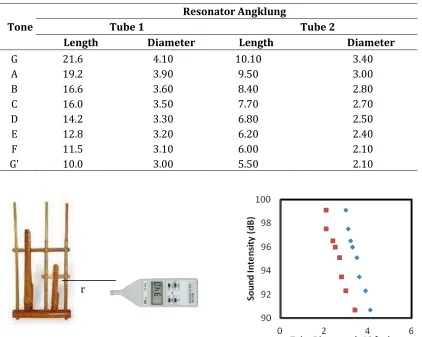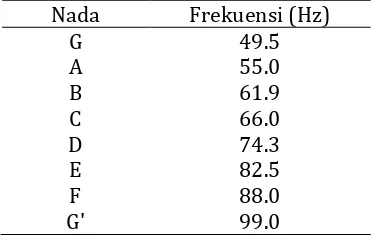Available online at http://journal.walisongo.ac.id/index.php/jnsmr
Analysis of Angklung Sound Intensity as a Acoustic Instrument
Rizka Silviana Hartanti1, and Budi Astuti2
1Physics Education Postgraduate Program Universitas Negeri Semarang, Unnes Campus Bendan Ngisor
Sampangan Semarang 50233
2 Department of Physics, Universitas Negeri Semarang, Semarang State University, Campus Sekaran
Gunungpati, Semarang, Central Java, Indonesia.
Corresponding author: [email protected] Recived: 12 April 2016, Revised : 15 May 2016, Accepted: 24 June 2016.
Abstracts
The purpose of this study was to analysis of angklung sound intensity. The research method is using angklung musician 2 octaves. Each consists of two tube tone that sounded from the tone of G to G ', length and diameter of the tube every tone becomes independent variable, while intensity of the sound produced becomes dependent variable. Sound intensity is measured using a Sound Level Meteris placed with a constant distance. The result showed that G tone was a low tone which had a frequency of 49.5 Hz, first tube had 21.6 cm length and 4.1 cm diameter, second tube had 10.1 cm length and 3.4 cm diameter produced the sound intensity of 90.7 dB. G’ tone was a high tone which had a frequency of 99 Hz, first tube had 10 cm length and 3 cm diameter, second tube had 5.5 cm length and 2.1 cm diameter produced the sound intensity of 99.1 dB. It can be concluded that the higher the frequency, the greater the intensity of the sound produced. The shorter tube length and the smaller tube diameter, the greater the intensity of the sound. ©2016 JNSMR UIN Walisongo. All rights reserved.
Key words: Angklung; Intensity of sound; Tube diameter; Tube length.
1.
Introduction
Every region in Indonesia had many culture one of which the traditional musical instrument [1]. Traditional musical instruments in Indonesia has been known to foreign countries, one of which angklung. Angklung was one of Indonesia's cultural heritage and has been there hundreds years
ago. Gubrak’s angklung is the oldest angklung
[1,2].
four tubes. Angklung consists of two tubes will produce a single tone with a tone octave. Angklung consists of 3 tubes will produce a single tone with a two tone octaves while angklung consists of 4 tubes produce a single tone and two tone octaves and chord tone [5]. Angklung is played by shake and vibrated by bamboo, because apus / rope bamboo is easy to obtain and more affordable. Character of Apus / rope bamboo is trunked strong, tough, straight, and has a long fiber and flexible [8].
Several studies about traditional musical instruments, such as frequency measurements on slenthem gamelan declared that there is an influence on laying resonator tube to the length sound produced by slenthem [9]. There is also research about traditional musical instruments on the frequency measurement of the saron gamelan declared that the frequency of the saron gamelan is affected by the width, thickness and size of the resonator holes [10]. Research on the angklung through tube tone and octave tone were released declared that the fundamental frequency of resonance is influenced by the length and diameter of the air column [11]. The relationship between the frequency and the length of the pipeline is getting shorter pipe organ, the greater the frequency of sound produced [12].
Acoustics is a branch of science that studies the sound [13]. The sound is a longitudinal wave [14] which occurs because of the objects vibrate heard by the ear and vibrate the eardrum. The amplitude was increasing, then the sound intensity increases, so the amplitude depends on the frequency [15]. The vibration frequency tones can determine high and low of a tone, while amplitude determine weak and loud of a tone [16]. Sound intensity is the energy produced per unit area. The greater of energy, the
also getting greater, so the sound intensity is directly proportional to the frequency[17,18]. Each sound source produces a different sound intensity [19].
From the description above that alignment of angklung tone still use the sense of hearing. The sense of hearing owned by every person has a different sound, thenneed to standardization of the angklung manufacture to align sound in every angklung tone by measuring the intensity of sound in angklung, purpose of this study was to analyze the angklung sound intensity from G tone to G 'tone.
2.
Experiments Procedure
This research was conducted to determine the effect of resonator tube to sound intensity produced by angklung. The variable of this research is the length and diameter of the angklung tube as independent variables and the sound intensity of angklung as the dependent variable. The control variable in this study is use angklung from apus/rope bamboo.
This research will measure the sound intensity produced angklung. The tool used in this research is a Sound Level Meter. The
material used in this research is an angklung pengamen who has 2 octaves tone. Intensity
is measured is from a low tone to high tone on
the angklung pengamen , tone G to G '.
Data were taken by measuring the length and diameter on every angklung tone from G to G' as a variation are presented in Table 1. The next step is shake each angklung starting from a low tone G to high tone G ', so that to produce sound. Sound intensity measurement using the Sound Level Meter is placed at a distance (r) constant. Figure 1 is a schematic measurement sound intensity on the angklung tone with Sound Level Meter.
Table 1. Tube length and tube diameter variation on G-G’ angklung tones
Tone
Resonator Angklung
Tube 1 Tube 2
Length Diameter Length Diameter
G 21.6 4.10 10.10 3.40
A 19.2 3.90 9.50 3.00
B 16.6 3.60 8.40 2.80
C 16.0 3.50 7.70 2.70
D 14.2 3.30 6.80 2.50
E 12.8 3.20 6.20 2.40
F 11.5 3.10 6.00 2.10
G' 10.0 3.00 5.50 2.10
Figure 1. Measurement sound intensity angklung tones with Sound Level Meter.
3.
Result and Discussion
Experiments were performed using angklung apus / rope bamboo of G to G ' tones, then determine the sound intensity using the Sound Level Meter is placed with a constant distance when measurements. Every note on the angklung has different a length and diameter of the tube. Angklung used in this
research is 2 octaves angklung pengamen
consists of two tubes has different of length and diameter as presented in Table 1. The relationship between the tube diameter from the G to G ' tone with the sound intensity produced is presented in Figure 2.
Figure 2. Graph of relationship between tube diameter G-G’ tones to sound intensity
From Figure 2 shows that the diameter of the tube 1 is greater than the diameter of the tube 2. The tube diameter greater then the sound intensity produced is gets smaller. The higher the tone then diameter tube is gets smaller, the tube diameter is smaller then the sound intensity produced increases. The relationship between tube length from G to G' angklung tones to the sound intensity produced is presented in Figure 3.
Figure 3. Graph of relationship between tube length G-G’ tones to sound intensity
From Figure 3 shows that the angklung has tube length 1 greater than the tube length 2. The smaller the diameter of the sound intensity increases, The higher the tone then the length tube is getting shorter. The shorter tube length then the sound intensity produced increases. In previous researches of the tone frequency to 2 octaves of G to G ' tones [1] is presented in Table 2.
Table 2. Frequency of 2 octaves angklung G-G’ tones
Nada Frekuensi (Hz)
G 49.5
A 55.0
B 61.9
C 66.0
D 74.3
E 82.5
F 88.0
G' 99.0
The relationship between the frequency to the sound intensity on 2 octaves angklung of G to G' tones is shown in Figure 4. From Figure 4 shows that the higher the frequency then the sound intensity is getting greater. From the results that have been obtained is corresponding with the theory and previous research that the higher the tone, the higher the frequency and sound intensity getting
greater, so the frequency is proportional to the sound intensity [18]. The sound intensity is also influenced by the tube diameter and tube length, the smaller the tube diameter then sound intensity getting greater and the shorter the tube length then the greater the sound intensity [11]
Figure 4. Graph of relationship between frequency
G-G’ tones to sound intensity
4.
Conclusion
The tube length and the tube diameter affect the sound intensity, that the smaller the tube diameter and the shorter the tube length, the sound intensity produced increases. Sound intensity is also proportional to the frequency that the higher the frequency then the greater the sound intensity produced.
Acknowledgment
The author wish to thank to Department of Physics, Universitas Negeri Semarang for the financial support.
References
[1] M. Masiswo, G. B. Mandegani, V. Atika, Karakteristik Angklung Berbahan Bambu Apus (Gigantochloa apus),
[2] A. Pratiwi, Pelestarian Angklung sebagai Warisan Budaya Takbenda dalam Pariwisata Berkelanjutan di Saung Angklung Udjo, Bandung, Tesis,
Universitas Udayana, 2013.
[3] A. Angraini, dan G. Yudoko, Usulan Perumusan Strategi Perusahaan dengan Analisis SWOT : Studi Kasus PT Saung Angklung Udjo Bandung, Jurnal Riset Manajemen & Bisnis, Vol. 4, No. 1, pp 74-88, 2009.
[4] D. Supriadi, Model Pembelajaran Musik Angklung Sunda Kreasi di Sanggar Saung Angklung Udjo Nglagena, Padasuka Bandung Jawa Barat,
Harmonia Jurnal Pengetahuan dan Pemikiran Seni, Vol. 7, No.3, 2006. [5] D. Hermawan, Angklung Sunda Sebagai
Wahana Industri Kreatif dan Pembentukan Karakter, Jurnal Seni dan Budaya Panggung,Vol. 23, No. 23, pp.171-186, 2013.
[6] Badan Standar Nasional, Kegunaan Bambu, SNI 8020, 2014.
[7] P. Oktaviani, E. K. S. H. Muntasib, dan E. A. M. Zuhud, Perencanaan Interpretasi Berbasis Konservasi Bambu Sebagai Bahan Baku Angklung di Saung Angklung Udjo, Seminar Sekolah Pascasarjana IPB,2016.
[8] Suwartanti, Perilaku Mekanik Tarik Bambu dan Potensi Aplikasinya Sebagai
Perkuatan Tanah pada Timbunan,
INERSA, Vol. 1, No. 1, pp. 39-47, 2005. [9] A. Ardiansyah, L. Yuwana, Suyatno, G.
Prajitno, D. Basuki, dan S. Indrawati, Pengaruh Resonator Terhadap Bunyi Slenthem Berdasarkan SPL dan Frekuensi, Jurnal Teknik Pomits, pp. 1-7, 2014.
[10] Mitrayana dan V.J. Cytasari, Pengukuran Frekuensi Bunyi Saron Demung Laras Pelog Gamelan Jawa Menggunakan Perangkat Lunak Visual Analyzer, Jurnal Fisika Indonesia, Vol. 18, No.54, pp. 73-76, 2014.
[11] M. Ridzuwary, M. Zainal, S. A. Samad, A. Hussain dan C. H. Azhari, Pitch and Timbre Determinastion of Angklung,
American Journal of Applied Sciences,
Vol.6 (1), pp. 24-29, 2009.
[12] E.A. Muhafid, dan M. R. Primadi, Pengembangan Alat Eksperimen Bunyi dengan Sistem Akuisisi Data Berbasis Smartphone Android, Jurnal Fisika, Vol. 4, No. 2, pp. 83-87, 2014.
[13] M.N. Massikki, Performa Akustik Pada Ruang di Sekolah Luar Biasa Negeri Marwola Kabupaten Sigi, Jurnal SMARTek, Vol. 8, No. 3, pp. 224-230, 2010.
[14] K. Anwar, M. Isnaini, dan L.S. Utami, Analisis Akord Dmayor Pada Alat Musik Gitar Acoustik, Jurnal Fisika Idonesia,
Vol. 18, No. 54, pp. 77-81, 2014.
[15] Jamaludin, D. Suriyanto, M. Adiansyah, M Sholachuddin, I. Sucahyo, Perancangan dan Implementasi Sound Level Meter (SLM) dalam Skala Laboratorium Sebagai Alat Ukur Intensitas Bunyi, Jurnal Pendidikan Fisika dan Aplikasinya (JPFA), Vol. 4, No. 1, pp. 42-46, 2014.
[16] A.H. Wafiroh, Pengukuran Tingkat Kebisingan di Lingkungan SMPN 2 Jember, FMIPA Universitas Jember, 2013.
[17] T. Sethapakdi, Sound Intensity of a Drum, ISB Journal of Physics, Vol.6 (1), 2012.
[18] Y. Purwiyantini, M. P. Aji, dan Sulhadi, Analisis Akustik Alat Musik Rebana, 2016.

